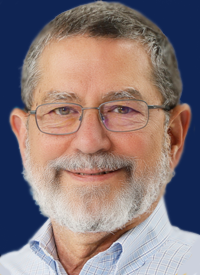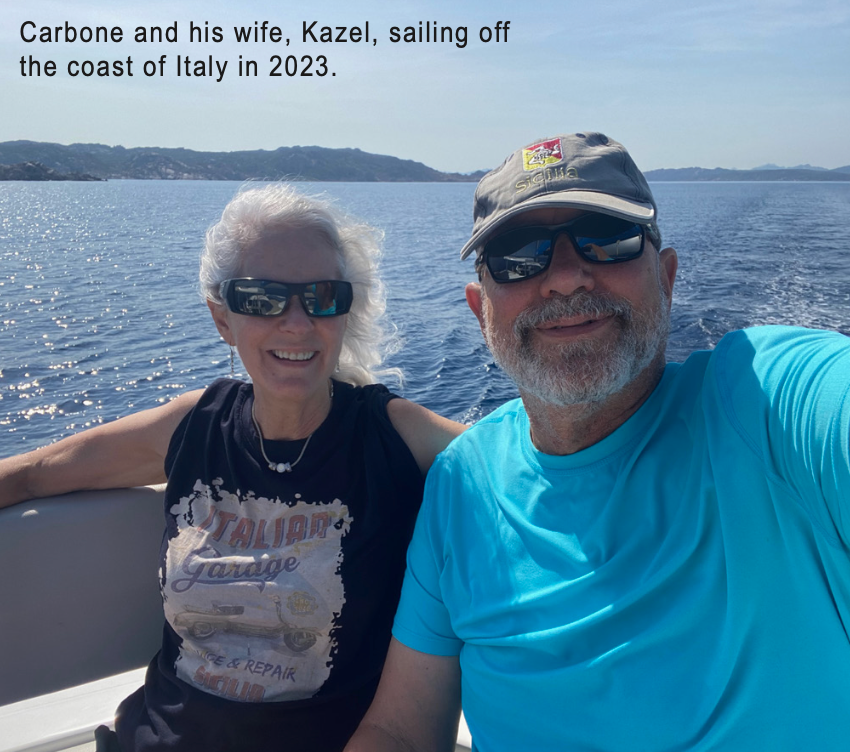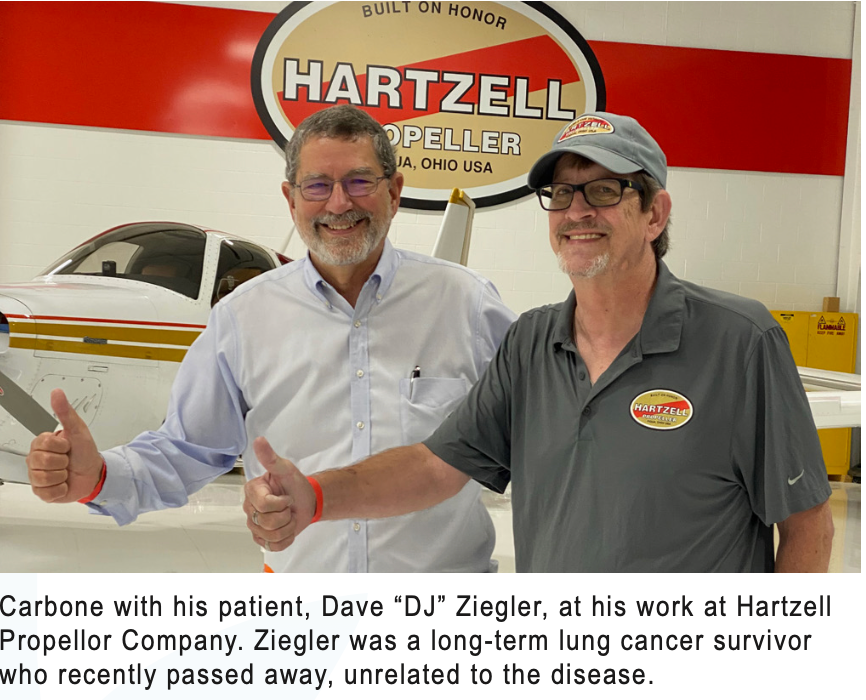Feature
Article
Lung Specialist Finds His “Sweet Spot” at the Intersection of Medicine and Technology
Author(s):
David P. Carbone, MD, PhD, sought to transform lung cancer care and did it—but didn’t anticipate the personal journey it would put him on.
David P. Carbone, MD, PhD

On July 28, 2023, GO2 for Lung Cancer, an organization that supports the care and well-being of patients with lung cancer, awarded the 2023 Bonnie J. Addario Lectureship Award to David P. Carbone, MD, PhD, for his work developing treatments for patients with lung cancer. The award was given to Carbone at the 24th Annual International Lung Cancer Congress.
Carbone, the 2023 Giant of Cancer Care winner in the lung cancer category, is director of the James Thoracic Center at The Ohio State University Medical Center and coleader of the Translational Therapeutics Program at The Ohio State University Comprehensive Cancer Center–James in Columbus, but the origin of his commitment to medicine and time spent improving the lives of patients with lung cancer is far from traditional.
The eldest of 7, Carbone was born in 1955 in Albany, New York to an Italian family, living with not only his parents and siblings but also Italian-born grandparents and an Italian-born great-aunt. His father, Paul Carbone, MD, worked in the Public Health Service as an oncologist and helped develop the drugs his son would rely heavily on in his practice. The family moved every 2 years or so, and Carbone lived in California, Georgia, and New York before settling in Maryland when his father started working at the National Institutes of Health in Bethesda.
Despite the influence of his father’s profession, medicine was not Carbone’s initial infatuation. He found himself drawn more to electronics than to the human body, and he packed his childhood bedroom with electronics equipment, radios and antennae, and model airplanes, which he enjoyed designing and flying. “There was this informal dump down the dirt road from us where people would throw [away] old TV sets and things, and I would just scrounge around in there for old electronics. I just taught myself electronics and I figured out how to trace the circuits and figured out how to fix these things,” Carbone said.
Carbone during his acceptance speech at the 2023 Giants of Cancer Care awards ceremony in June.

Carbone’s fascination with electronics introduced him to the ham radio community and he used the equipment he built to talk to people all over the world. Soon Carbone received the highest-level ham radio license and on his first attempt became licensed to operate commercial radio and television stations. At the age of 16 years, Carbone applied to several local TV stations. “I never got a single [reply] because they couldn’t believe that I had taught myself all this stuff,” Carbone said. Realizing the importance of
a well-rounded education, he went to Amherst College, a small liberal arts school in Massachusetts, where, in addition to history, art, and philosophy, he continued his interest in math, physics, and electronics, and became the chief engineer for the college’s FM radio station.
Carbone’s knack for electronics drove his decision to major in physics, and he planned to pursue electrical engineering after graduation. “I [went to Amherst] intentionally because I was kind of a geeky, technologically oriented person growing up, and I knew that I wanted to be more like my dad and his doctor friends in terms of being able to interact with people and to write and to think and not just compute,” Carbone said.
He didn’t realize that this was the first of many decisions to set him on his path toward medicine. While at Amherst, he secured a summer job at the University of Wisconsin in medical physics designing computer hardware circuits. “The project we were working on was to build the first real-time digital image processing system for doing what’s called K-edge imaging of hearts, video of parts, to look at coronary arteries. This was back in the early 1970s when computers were the size of refrigerators,” Carbone said. After completing his second summer in Madison, he realized that he preferred the medical component over the wiring aspect of the position.
Laying the Groundwork
The stars aligned, or so he thought when he realized he had taken all the prerequisite courses to apply to medical school. He applied and was accepted to The Johns Hopkins University School of Medicine. “I got into Johns Hopkins Medical School but after starting, I hated it because, at that time, it was all memorization. There was no science, no scientific thought involved in the medicine,” Carbone said. “I couldn’t imagine myself going through and doing what William Osler, [FRS, FRCP] told me to do 100 years ago, 5 days a week for the rest of my life,” Carbone said. Osler was one of the founding professors of Johns Hopkins Hospital and is known as “the father of modern medicine.”
Carbone with Alessandra Ferrajoli, MD, of The University of Texas MD Anderson Cancer Center, and Robert Goldsmith, of MJH Life Sciences.

As a first-year medical student, he decided to apply to the combined MD PhD (MSTP) program, which had just started at Johns Hopkins. “That combination proved to be my sweet spot. I loved taking care of patients, but I liked the research and applying science to medicine and vice versa and learning from patients to learn new science,” Carbone said. “I’ve been very fortunate throughout my career to be able to balance that clinical medicine and basic science [and] translational research and, to me, that’s been an immensely satisfying combination.” Several years later, Carbone earned his PhD in molecular biology and genetics, and as a resident wondered how he could fuse these two technical knowledge bases, as still at that time there were not many intersections between molecular biology and medicine.
Carbone found himself at a lecture at Johns Hopkins given by John Minna, MD, who was head of the National Cancer Institute (NCI) Navy branch and conducting lung cancer research, and was also a 2015 Giant of Cancer Care inductee. The lecture focused on how big of a problem lung cancer was, with median overall survival ranging from 4 to 6 months, and the recently discovered recurring acquired genetic abnormalities.
After the lecture, he had a conversation with Minna, and Carbone was convinced that he had found the crossroads he had been looking for. “I applied [for] an oncology fellowship at the NCI and to work in his group, and he accepted me into his lab [in 1988], and I just thrived in that environment,” Carbone said. The focus of his research was genetic abnormalities in lung cancer, and he and his fellow lab members performed the first studies of TP53 and RB mutations in lung cancer. “He was a terrific mentor in every way. If I went up to him with a question, he would listen. If I had a paper I wanted him to review with me, he would do it right away, and he supported me in terms of letting me go to meetings and introducing me to people and those sorts of things that a good mentor does, and just being there to bounce ideas off of,” Carbone said.
However, before finishing his fellowship, Minna left for The University of Texas Southwestern Medical Center in Dallas. After completing his fellowship, Carbone applied for a faculty position there, where the two continued to work together for five years, leading to several senior and first-author papers for Carbone.
Carbone and his wife, Kazel, in a yellow sunflower field in 2017 near Xining, China.

Eager to take the next step in his career, Carbone left for Vanderbilt University after being recruited by David P. Johnson, MD, and Harold L. Moses, MD, and he spent 16 years there. He hit the ground running, with the promise of building a translational program worthy of receiving a major lung cancer grant. Five years later, his research group received funding for the university’s first lung cancer Specialized Programs of Research Excellence grant in lung cancer.
Career Contributions
Whether gene therapy, immunotherapy, or targeted therapy, Carbone has had a hand in it, most recently authoring a paper on the survival benefit associated with a shortened course of chemotherapy plus combined checkpoint inhibition. However, he credits discovery equally to his collaborators as well as his mentees, in whom he says he works to instill a sense of confidence and curiosity, allowing them to contribute intellectually and not just manually.
“That’s the best way to make progress in science: Listen to people with opposing viewpoints and try to understand where they come from and maybe change your direction based on what they’re telling you,” Carbone said.
Though he is hesitant to tout his accomplishments, 1 area of research he recalled with pride was his work on the first neoantigen-specific peptide vaccine. The trial, which started in 1993, was published in 2005 and the results have since been more mainstream with the advancement of vaccine technology, in multiple diseases, including melanoma, leading to improved survival and patient outcomes. He spoke with equal gratification about the work that led to the discovery of the exact sequence of the EGFR mutation, which would later be corroborated by researchers at Harvard Medical School and Dana-Farber Cancer Institute.
Carbone and his wife, Kazel, sailing off the coast of Italy in 2023.

“To me, it’s not so much about credit. I got enough credit; I’m a full professor. I have been president of the International Association for the Study of Lung Cancer [IASLC]. I know I’m not going to win a Nobel Prize, but I feel satisfaction in making some contribution to the field,” Carbone said.
Patient-to-Patient Advocate
Carbone also has a long-standing association with patient advocacy foundations.
“The role of patients and patient foundations can’t be understated, and this really is a source of satisfaction in my career to this day,” Carbone said, noting that one of his patients confounded the Lung Cancer Foundation of America.
A glimpse into Carbone’s office offers a peek at the deep connection Carbone has with his patients. On a shelf is a large white ribbon for The White Ribbon Project, an organization founded by lung cancer survivor Heidi Onda and her husband, Pierre. The organization works with advocates to make and share white ribbons as a symbol of hope for those who have been affected by lung cancer. Carbone has personally made dozens of them. Founded in 2020, the organization has grown exponentially, and they are now appearing everywhere, in homes and offices around the world.
Carbone giving a presentation during the International Association for the Study of Lung Cancer 2016 World Conference on Lung Cancer in Vienna, Austria.

“I saw how they were making [the ribbons]. They had a jigsaw and they were cutting each one manually,” Carbone said. Having built a woodshop over the years, Carbone offered to help with production, using his band saw to cut 8 ribbons at a time. He now invites members of the Ohio State thoracic group to his home to sand and paint the ribbons, adding both team bonding and increased efficiency to the cause. He also volunteers as a scientific adviser for many lung cancer foundations, lending his manual and leadership skills in any way he can.
Carbone’s commitment to patient advocacy stems not only from his relationships with his patients but also from his experience as a patient himself. In 1999, he had diagnosed himself with superior vena cava syndrome. After ordering x-rays and presenting his images at the Vanderbilt thoracic tumor boards, he received news he had, until this point, been the one delivering: He had cancer. He learned he had mediastinal B-cell lymphoma. Treatment was a partial lobectomy with chest chemoradiation, which has left him with a heart condition that persists to this day.
“The first papers that I read on my exact stage and diagnosis had a 17% 5-year survival [rate], and I had kids under the age of 10. It was devastating to think about what would happen if treatment wasn’t successful. I learned empathy for patients and the impact on families and the impact of the diagnosis on work and everything else in a person’s world through that experience,” Carbone said.
The Next Chapter
Following his transition from Vanderbilt to Ohio State in 2012, he was one of 3 thoracic oncologists. Now, the department has 10 thoracic oncologists, with Carbone at the helm of the Thoracic Center there, and working hard to improve the outcomes of cancer patients there, including promoting lung cancer screening and disease-monitoring initiatives. “Lung cancer screening was a fairly new concept, but I thought it was one that was super important,” Carbone said, adding that when he arrived, there was no lung cancer screening program, so he started one.
Carbone near Egyptian pyramids at a lung cancer meeting.

Carbone also recognized that incidentally discovered lung nodules on scans done for another purpose were not being appropriately followed through the normal channels. “Together with Jasleen Pannu, an interventional pulmonologist he helped recruit from Vanderbilt, they found that more than half of those were not appropriately managed,” Carbone said. “We then developed an organized incidental lung nodule clinic to ensure that follow-up continued for patients. We do thousands of screens and other CT scans including the lungs per year and have identified many early-stage lung cancers.
Throughout my career, I haven’t focused on any 1 aspect of lung cancer. I’ve just really focused on improving the outcomes for patients with this disease in any way I can, and however we can accomplish that has been something that I’ve been interested in doing,” Carbone said.
As for the future, Carbone acknowledged that his work is not done, saying the field is in its infancy of understanding many things, including the public health risk e-cigarettes pose.
Carbone on his motorcycle at a lung cancer fundraiser in 2017.

“Some of my colleagues have shown that all of the changes that we observe with tobacco smoke on the lung epithelium are exactly the same ones observed in people exposed to reference e-cigarettes, and we haven’t really studied the impact of all the 50 other chemicals that are put into these devices in the real world,” Carbone said.
Returning to His Roots
During Carbone’s bout with cancer, his father offered to help and could have directed his appointments and treatments, but instead picked up what Carbone himself could not. “He started just doing chores around the house, trimming my hedges, and mowing my lawn. To me, that was really what I needed at that time. That was humbling,” Carbone said.
After Carbone recovered from treatment in 2000, his father invited him to go to Sicily for 2 weeks. Carbone almost declined because he had to take a 2-week leave of absence, which he had never done. They toured Sicily, visiting Palermo and traveling around the island. “I just fell in love with the place. It was my first visit to Italy,” Carbone said.
Three months after they returned, his father died at the age of 70 years. I would never have forgiven myself if I had not gone with him on this trip and had the one-on-one time with him, which was rare in a family with 7 kids.
Carbone with his patient, Dave "DJ" Ziegler, at his work at Hartzell Propellor Company, Ziegler was a long-term lung cancer survivor who recently passed away, unrelated to the disease.

“I went back to Italy a couple more times and decided that life was short and [told myself] I would buy a house there, and I did about 20 years ago. My wife and I go to the house regularly now and we both really love it there,” Carbone said.
Carbone and his wife, who was born and raised in a small town in Tennessee, rented a sailboat off Sardinia in the summer of 2023 and spent the week sailing, visiting Sardinian and Corsican ports and sampling the local cuisine, but he prefers Sicilian food. “Sicilian food is just fresh. It’s simple and flavorful,” Carbone said, paying homage to his favorite dish, pasta con le sarde, or pasta with sardines, and another Sicilian favorite, with arancine, or rice balls. There’s a street vendor (also named Carbone, and born the same month as him) in the beach town near Carbone’s house where he has made a habit of buying arancine after stocking up on fruits
and vegetables.
Outside his career, where Carbone is content to continue his current path, guiding the next generation of physician-scientists and contributing to patient care, he also looks forward to getting together with his son and 3 younger daughters, all of whom have traveled with Carbone internationally.
“I used to think I wanted to be a cancer center director or a department chair of medicine, but I’m very happy with team building and really making a functioning thoracic oncology program that is a full-service group all the way from pulmonologists to radiologists to surgeons and doing a good job for patients,” Carbone said. “What I want to be remembered for is the impact I’ve had on patient care, on my patients, and on the young people that I’ve worked with and mentored.”









